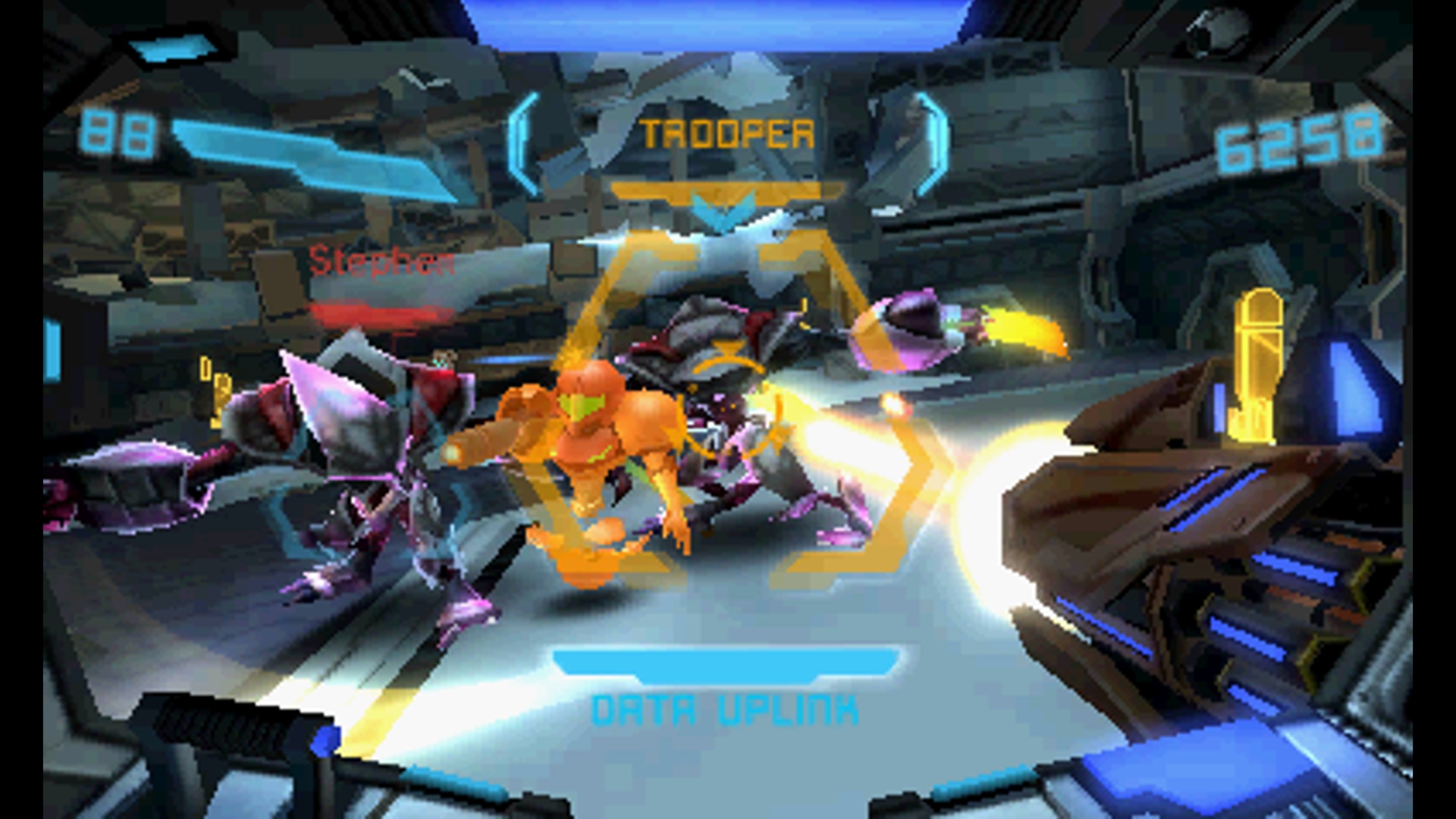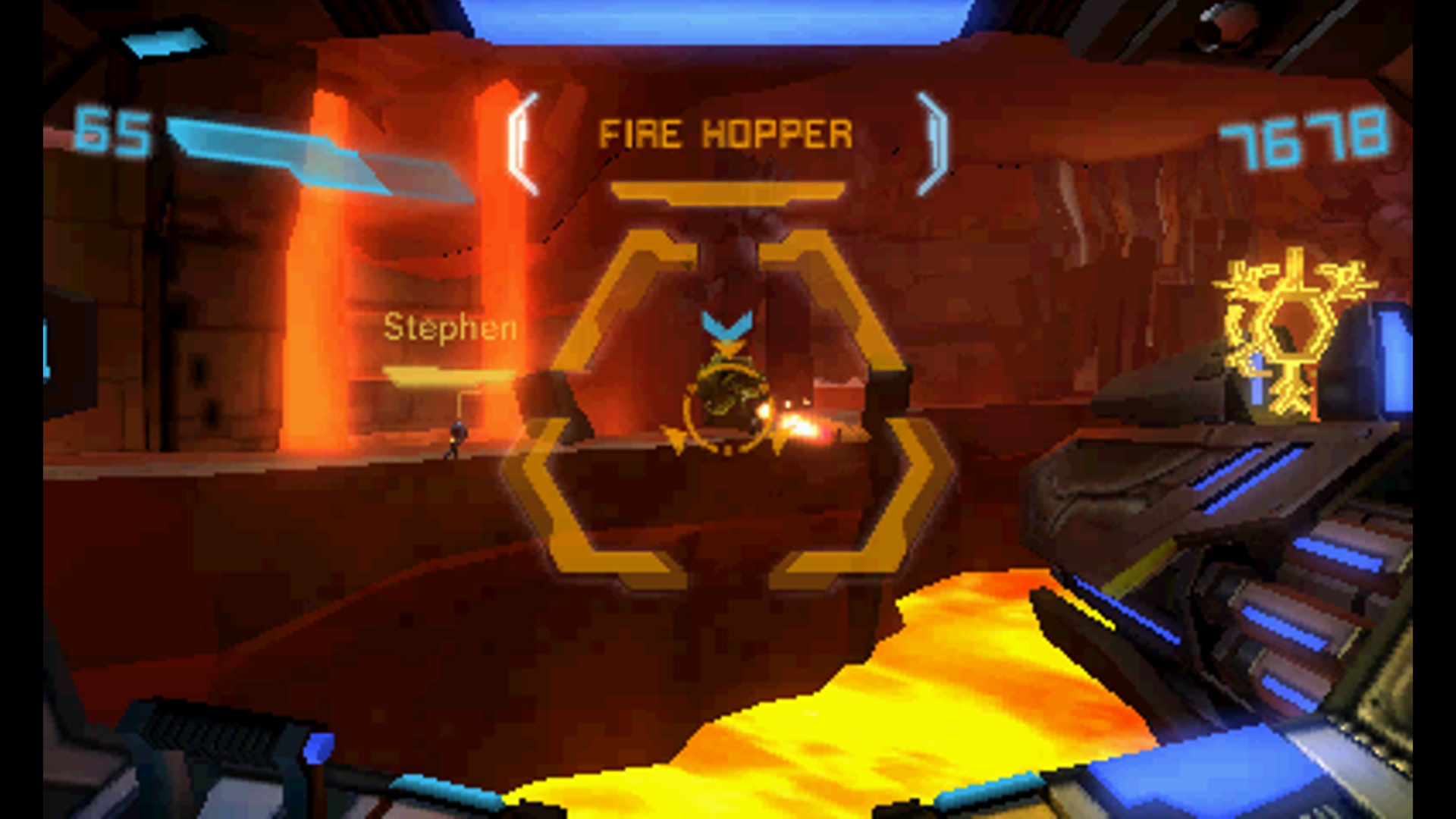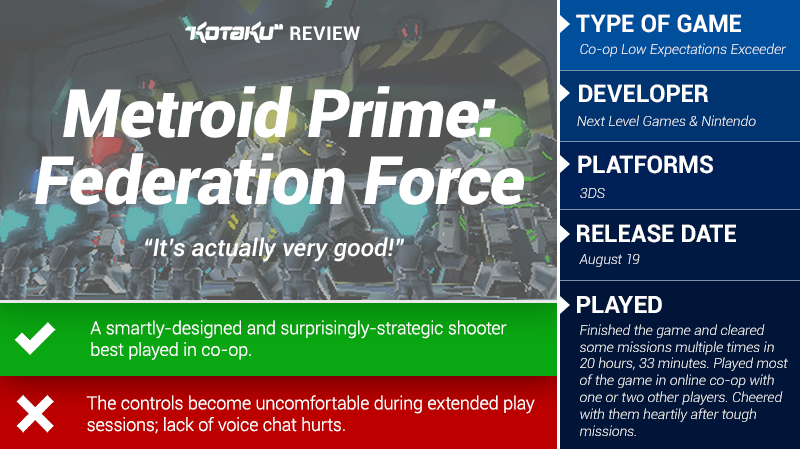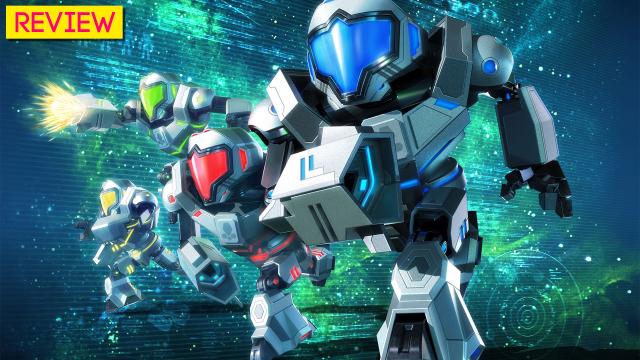Despite abundant expectations that it would be bad, Nintendo’s new Metroid spin-off turns out to be very good.
Metroid Prime Federation Force, which runs on the 3DS, is the first game with the M-word in its title since 2010. It is barely a Metroid game, something series fans sniffed out the moment it was first shown in mid-2015. You don’t play as the bounty hunter Samus Aran. Your time playing isn’t mostly spent doing sci-fi archaeology on a largely abandoned world. You don’t slowly discover new jumping, running and laser beam abilities that let you access previously inaccessible areas. If you have been starving for a new Metroid game — I have — the odd and initially unwelcome Federation Force isn’t it.
Metroid Prime Federation Force is, however, a smartly-designed strategic first-person shooter that is very fun to play, especially with multiple teammates. It is, believe it or not, Nintendo’s answer to a Destiny raid or to the best missions of co-op games such as Left 4 Dead or Gears of War. It’s not as technical and tactical as the most hardcore versions of the military games Ghost Recon or Rainbow Six but it is a game for people who like discussing loadouts and outlining tactics with their co-op gaming partners before diving into a mission together.

3DS games don’t show well in big screenshots. Federation Force further suffers from having a fairly plain look that doesn’t look good in stills. On the 3DS itself, the game looks good enough. It’s not the head-turner that the console Metroid Primes were, but the graphics get the job done. Here, you’re seeing from the perspective of GameXplain’s Derrick Bitner, who played through much of the game with me. I’m on the left side, obscured by a Space Pirate who is distracted by the Samus decoy I dropped into battle. Thanks to Derrick for the screencap.
Federation Force was designed by frequent Nintendo partners Next Level Games and overseen by producers from Nintendo’s Kyoto HQ. The game is spread across 22 missions, each of which can be played by one to four players in local or online co-op. Missions involve some mix of light exploration and heavy combat. They run 10-20 minutes, less if you replay them to hit time goals. In these missions, each player controls a space marine who pilots a big mech suit. Players customise the mechs with abilities, weapons and items that will best help them and their team overcome a given set of challenges.
The missions are wildly varied and almost all good. There are base infiltrations and boss battles, simple early layouts that encourage teammates to clear out rooms together or attack massive enemies from opposite sides. There are missions where you hold your ground and missions where you are constantly on the move.
One mission challenges your team to trap massive quadrupedal ice beasts in four cages, with a bonus reward if you can capture two in one of the cages. As you herd these beasts, you’re attacked by Space Pirates, a returning faction of villains from the Prime series who infest most of the new game’s levels. The action in that one is frantic and fun as you mix charge shots to defeat the Pirates while tapping the beasts with regular shots to goad them to charge into open house-size cages.
A few missions use the mechanics taught in Blast Ball, the so-so 3-on-3 sports game bundled with Federation Force. The chief mechanic there involves shooting a big ball into a goal, which would have seemed more ridiculous in a pre-Rocket League world. This riff on outer-space soccer comes into play in some surprising ways during the conflict with the Space Pirates.
Some of the game’s most interesting levels force you out of your mech suit and leave you weaponless. I played my favourite of those online with two people, a GameXplain video producer in Pennsylvania and the Dutch Nintendo reporter Nintendaan. The mission began with an ambush attack knocking us out of our mechs and down into a dangerous cavern filled with fireballs. We had to escape a maze down there and then came upon the GameXplain guy’s mech. He got in it and protected us with supporting fire as we dashed deeper into the level.

That’s me running across the bridge, out of my mech suit, while GameXplain’s Derrick Bitner provides covering fire. Thanks to Derrick for the screenshot.
You don’t notice it most of the time, but the mechs in the game are supposed to be huge. The marines inside them are relatively minuscule. The enemies are huge, too (there’s a plot explanation for this). The game mostly squanders this sense of contrasting scale by making most of its doors, rooms, and vehicles giant-sized, but in this one level the contrast creates an exciting division between player roles. As we proceeded, Nintendaan was able to get his mech as well, making it two player stomping around and shooting from their mechs while tiny me raced across skinny bridges, asking them for covering fire so that massive enemies wouldn’t kill me. This was the kind of level design I expected to see in a Destiny raid, not an unheralded 3DS shooter, but it’s the kind of level design I want more of..
You find “mods” for your mech hidden in the game’s levels and then can choose to use them in subsequent missions. Looking for them encourages some of the poking around — melting ice walls with a fire gun, blowing up vents with missiles — befitting a Metroid game after all. In some of these missions it’s better to go in with strong armour. In others, you might want to bring a powered-up freeze beam or super-charged set of missiles or enhanced repair capsules.
At first the choices appear to be few and not very meaningful, just vague nods toward letting teams divide themselves into traditional multiplayer roles like healer or tank. Soon, however, curious players will find themselves with dozens of unexpected mods and up to three slots to insert them. There’s a mod that electrifies your deployable shield domes. Another adds a freeze or burn effect to the Samus-shaped decoys that you can deploy to distract enemies.
If that doesn’t sound complex enough for you, consider this: before starting a level, players pick from their own available mods for their mechs but then collectively choose from a pool of weapons and items available for a given level. One player might take all the missiles, another the slow beam. There’s even a scan beam that a player or two can use to shoot at an enemy and expose its weak points. Each player is restricted by a weight limit, so a team has to distribute abilities somewhat evenly.
All of this customisation makes the game stand out. As I played with others, we’d struggle with a level, then re-spec our mechs and go back and try the level again. A reckless death could break a mod, so we also had to play smartly. The game was testing our reflexes as well as our collective ability to plan and execute effectively.
Teamwork is ideal, but you can play Federation Force by yourself, if you really want to. I did at first, aided by a mod that doubled the power of my guns and halved the power of enemies’. But it gets really tough, especially because so many of the levels seem designed for players to split their roles. You can bring flying drones into a solo game to assist you. That helps. They might, say, carry a key item out of the level for you, but that level is far easier if a person carries it while other players flank them and shoot down enemies.
Federation Force is more easily recommendable for people who are up for playing with others. You can do that locally or online. It’s best to play with people you can talk to, so it’s a pity Federation Force doesn’t support voice chat and instead expects players to communicate via a selection of canned prompts.
The game’s controls may also be controversial. On a regular 3DS, players will need to aim vertically by tilting the handheld up and down. On a New 3DS, players can use the system’s analogue nub as a second analogue stick. Both are serviceable options, but both become slightly painful after hours of play. The 3DS simply doesn’t feel well-suited for first-person shooter controls. It’s best to play this in relatively short sessions, not multi-hour marathons, which is the kind of lunacy you still embrace if you’re reviewing the game on a deadline, of course.

Metroid fans will find plenty of enjoyable series references in the game. Samus is a background character, never playable but presented throughout as a participant in the bigger struggle against the Space Pirates. She provides intel and, in a distant way, some support. Stuff that Metroid fans probably wouldn’t want spoiled happens, too. By the game’s end Federation Force does feel like it’s added something to the series lore. There’s even a set-up for a new adventure, which is encouraging for those of us who worry Nintendo has become largely disinterested in the series.
There’s little overlap in content or gameplay between Metroid Prime Federation Force and another recent release, the PS4 and PC game No Man’s Sky. There is, though, a mirrored case study in expectations, so low for the former and so high for the latter. Both have arrived differently than forecast. One is still cooling off from overheated hopes, settling in with an audience that may like the game for what it is rather than what they hoped it would be. Federation Force benefits from comparatively low expectations. While it may not be a classic Metroid, it proves to be the kind of strategic shooter not seen from Nintendo before. Its designers enter such uncharted territory with aplomb, and the resulting game is one of the most pleasant surprises of the season.

Comments
9 responses to “Metroid Prime: Federation Force: The Kotaku Review”
Ha! HA! Suck it, haters! Of course Next Level were going to come through. Still can’t believe all those whiney arseholes demanded they cancel this.
Also, judging by Blast Ball, this’ll be best played on 3DS/XL using the Circle Pad Pro, rather than the new 3DS.
Assuming it’s compatible with it.
Considering that Blast Ball is basically a demo for the game and does so, I feel it’s moved out of assumption territory :p
Oh, awesome. I hadn’t heard that it was, so that’s welcome news! 😀
Ah, I guess I did word it kind of vaguely originally. I hadn’t heard anything either, just decided to give it a try when dicking around with things the other week (and finding the n3DS control to be unsatisfactory), and found that thankfully it works. And works really well, imo the game feels like it was made for the CPP in the same way that Resi Revelations did.
Yay! Someone likes it! Go Nintendo!
http://www.metacritic.com/game/3ds/metroid-prime-federation-force
http://m.au.ign.com/articles/2016/08/19/metroid-prime-federation-force-review
Fankids:
Pro: Awesome game in every way
Con: Invisible PC isn’t Samus
0/10
“it’s a pity Federation Force doesn’t support voice chat and instead expects players to communicate via a selection of canned prompts”
It’s a massive benefit for playing cross-language. The messages should show in the player’s language. Having played FFXIV on a Japanese server, this sort of thing is a *very* good idea. Especially for avoiding fragmentation within a smaller player base.
While that’s true, there’s no reason to omit the option for voice chat completely. It should still be available should the players choose to use it.
BTW, the game doesn’t come out in Australia until September 3rd for some reason. Rip.